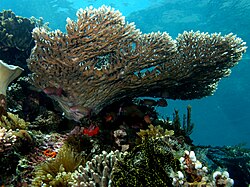Hexacorallia
| Hexacorallia | |
|---|---|
 |
|
| A stony coral, Acropora latistella | |
| Scientific classification | |
| Kingdom: | Animalia |
| Phylum: | Cnidaria |
| Class: | Anthozoa |
| Subclass: | Hexacorallia |
| Subgroups | |
Hexacorallia is a subclass of Anthozoa comprising approximately 4,300 species of aquatic organisms formed of polyps, generally with 6-fold symmetry. It includes all of the stony corals, most of which are colonial and reef-forming, as well as all sea anemones, tube anemones, and zoanthids, arranged within six extant orders. The hexacorallia are distinguished from another subclass of Anthozoa, , in having six or fewer axes of symmetry in their body structure and only single rows of tentacles. These organisms are formed of individual soft polyps which in some species live in colonies and can secrete a calcite skeleton. As with all Cnidarians, these organisms have a complex life cycle including a motile planktonic phase and a later characteristic sessile phase. Hexacorallia also include the significant extinct orders of the rugose corals and tabulate corals
Hexacorallia is considered to be monophyletic, that is all contained species are descended from a common ancestor, however it has been suggested that many of the current orders are not. Historically Ceriantharia and Antipatharia were considered to be a separate subclass called Ceriantipatharia, though more recent genetic studies place them in Hexacorallia with Ceriantharia as the oldest, or basal, group.
The subclass includes important coral reef builders the stony corals (Scleractinia), sea anemones (Actiniaria) and related tube-dwelling anemones (Ceriantharia), and zoanthids (Zoantharia). Antipatharia contains the black corals and Corallimorpharia are similar to anemones. The extant orders are shown below:
...
Wikipedia
